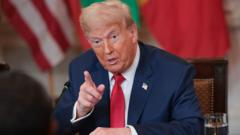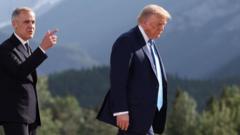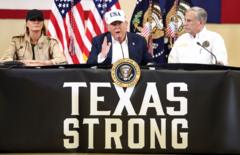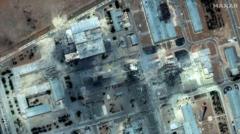In a bold move, President Trump reaffirms his commitment to tariffs, heightening tensions with multiple trading partners as he seeks new trade agreements to align with his economic vision.
Trump's Tariff Strategy: A New Era for Global Trade

Trump's Tariff Strategy: A New Era for Global Trade
President Trump’s approach to tariffs reshapes international trade dynamics, challenging past norms.
With an increasing focus on international trade policies, President Trump demonstrates a renewed interest in tariffs, stirring debates around their impact on the U.S. economy and global markets. His recent threats against over two dozen nations signal a departure from previous administrations' trade strategies, positioning tariffs as central to his economic policy.
Dismissing long-held beliefs about low tariffs promoting growth, Trump argues that past tariff reductions have undermined American industries, leading the country to rely on foreign imports. As he labeled himself a “tariff man,” the President emphasizes his intention to boost domestic manufacturing through substantial import taxes.
The stakes rose significantly this past week as Trump announced intentions to impose tariffs on 25 trading partners, effective August 1, unless they agree to more favorable trade terms. Among these countries are major U.S. trading allies including the EU, Japan, and Mexico, all of whom had previously engaged in negotiations to address Trump’s trade grievances.
Although some nations, such as India and Taiwan, may succeed in negotiating favorable terms to avoid these tariffs, the overall trajectory suggests that American tariffs could reach unprecedented levels, akin to those observed a century ago. Even newly discussed trade agreements with countries like Britain and Vietnam may result in maintaining high tariffs rather than their reduction.
As uncertainties mount regarding the outcome of these negotiations and the broader implications for global trade, the world watches closely to see how Trump's tariff policies will redefine relationships in the economic landscape.
Dismissing long-held beliefs about low tariffs promoting growth, Trump argues that past tariff reductions have undermined American industries, leading the country to rely on foreign imports. As he labeled himself a “tariff man,” the President emphasizes his intention to boost domestic manufacturing through substantial import taxes.
The stakes rose significantly this past week as Trump announced intentions to impose tariffs on 25 trading partners, effective August 1, unless they agree to more favorable trade terms. Among these countries are major U.S. trading allies including the EU, Japan, and Mexico, all of whom had previously engaged in negotiations to address Trump’s trade grievances.
Although some nations, such as India and Taiwan, may succeed in negotiating favorable terms to avoid these tariffs, the overall trajectory suggests that American tariffs could reach unprecedented levels, akin to those observed a century ago. Even newly discussed trade agreements with countries like Britain and Vietnam may result in maintaining high tariffs rather than their reduction.
As uncertainties mount regarding the outcome of these negotiations and the broader implications for global trade, the world watches closely to see how Trump's tariff policies will redefine relationships in the economic landscape.



















